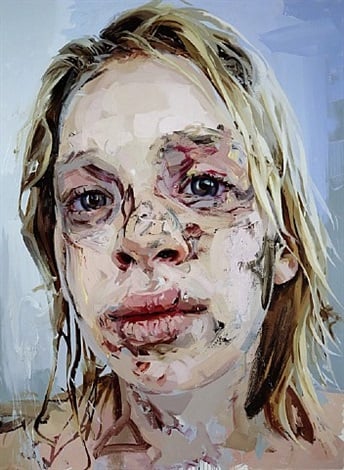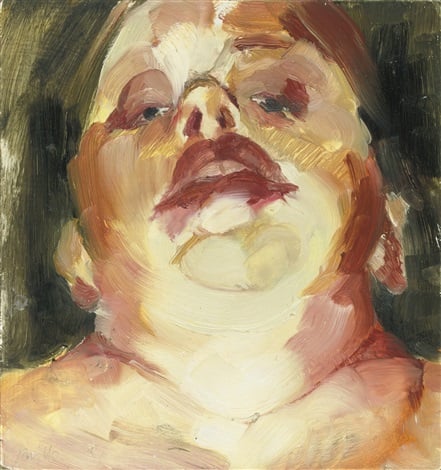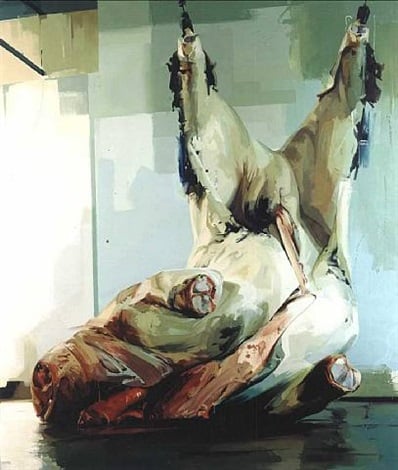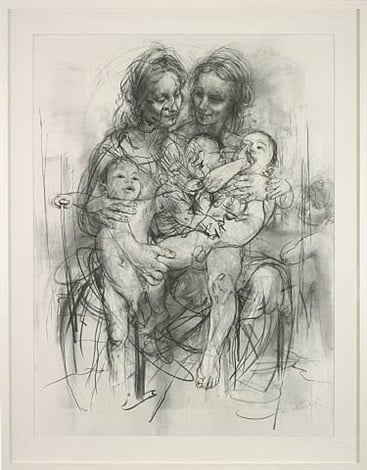Galleries
Will Jenny Saville Be Remembered as a Great Figurative Painter?
And can you believe that she only had her first UK solo exhibition last year?

Photo: courtesy New York Academy of Art
And can you believe that she only had her first UK solo exhibition last year?

Amah-Rose Abrams

Jenny Saville rose to fame alongside the Young British Artists in 1990s Britain, her monumental female nudes hailed as feminist genius. Her work stands apart from the other artists in the movement, if only for her figurative approach. Whether it was her otherness or the palpable darkness in her portraits, she has followed her own path since her initial rise to success.
Her focus on female flesh has lead to comparisons to Lucian Freud and Peter Paul Rubens, Saville’s work, although pictorial, has a heavier, darker emotional quality to it—perhaps more in the vein of British German painter and contemporary of Freud, Frank Auerbach.
Born in the Cambridge, Engand in 1970, Saville moved around the country throughout her young life due to her parents work in the education system. Her artistic promise was noted from a young age.

Jenny Saville Self Portrait (1992)
Photo: courtesy Crane Kalman Gallery
Saville rose to success incredibly quickly, and exhibited at the RCA Contemporary in 1990 while still studying for her degree at the Glasgow School of Art. A huge opportunity came her way when Charles Saatchi—who had been systematically buying up work by graduating and emerging artists since the late ’80s—saw her work on the cover of a magazine He sought it out and bought the work in question, and then tracked down Saville and asked her to produce a body of work.
“[…] What he did for me was amazing. I didn’t have lots of money. I make big paintings; I couldn’t afford to invest the time or money. Who would show them, let alone buy them?” she explained to the Guardian in 2005.”Charles was like, ‘Whatever you want, whatever is your dream, do it.’ Things I’d wanted to do for ages, I could do. And it made me a bigger artist.”
Saville showed work in both “Young British Artists III” in 1994 and then in “Sensation” in 1997 organized by Saatchi, and was one of the standout artists along with Damien Hirst, Chris Ofili, Tracey Emin, and Gillian Wearing.
In 1994, Saville’s work was featured on the cover of the seminal Manic Street Preachers’ record The Holy Bible (1994), a very dark yet critically acclaimed and controversial album. The painting that the band chose for their cover was the triptych Strategy (South Face/ front Face/North Face), (1994) which depicts a large woman. Viewed from below at three different angles, the woman’s size is highlighted and emphasized, offering a good example of Saville’s early focus: toweringly huge female nudes, that at once please the eye and utterly dominate the viewer.

Jenny Saville Torso 2 (2004)
Photo: courtesy Saatchi Gallery
“I wanted both in those pictures. A large female body has a power; it occupies a physical space, yet there’s an anxiety about it. It has to be hidden.” She explained to the Guardian in 2005, also mentioning a search for intimacy. “As if being in a mother’s arm [and] the anxiety that comes from living with flesh.”
Another work which exemplifies this period of Saville’s pactice is Plan (1993), a self-portrait which depicts Saville in the nude with contour lines—as though from a map—drawn all over her body.
“It [flesh] is all things. Ugly, beautiful, repulsive, compelling, anxious, neurotic, dead, alive,” she told the Guardian.
Saville’s main subject has often been herself and, subsequently, her children. She has said that she has little interest in portraits in the traditional sense, and wishes to mainly focus on flesh itself and the many ways it can appear.
In a collaboration with Glen Luchford, Saville produced the series Closed Contact (1993–96) first shown at Pace McGill in 1996 and then at Gagosian Beverly Hills in 2002. Saville posed for a series of photographs for the renowned fashion photographer, which shows her flesh—her body and face—pressed violently up against a sheet of glass, stretched and pulled to the point of abstraction. In an effort to better understand her subject of choice, Saville has observed many cosmetic surgical procedures in person, and wanted to capture the “pain and violence” in these procedures. Her observations of surgery also lead her to become interested in painting nude transsexuals throughout the transition process. These works, perfect in their controlled, gestural execution, are both intimate and disarming.
Despite selling work for staggering prices at auction and attracting comparisons to Egon Schiele, Freud, and Marlene Dumas, Saville remains humble in the ways she approaches her work.
“The older you get, the more doubtful you become, though I mean that in a good way. It’s like being an athlete. You get quite fit on your toes when you’re really pushing. But then you finish a piece, and you have to start all over again. On the other hand, I don’t have anything like the traumas I used to have, throwing paintbrushes or whatever. I used only to work on one piece at a time, and that’s where the trauma came. Now I move between paintings. When I start getting a bit dogmatic, I switch.”

Jenny Saville Reproduction drawing IV (after the Leonardo cartoon) (2010)
Photo: New York Academy of Art
Saville, astonishingly, didn’t have a solo exhibition in her native UK until 2014, when she moved back from Sicily to Oxford and started a family. Saville’s children and her pregnant self feature in “Oxyrhynchus,” her show at Gagosian Gallery. For the first time, there were also abstract works featured alongside her figurative paintings in this exhibition. She has also shown work with artists from other era, specifically Egon Schiele at the Kunsthaus, in Zurich in 2015.
With a such amazing technical ability and a strong artistic vision, it seems certain that Saville will go down in history as one of the great painters of 21st century. That being said, it seems that she is no rush to engage with the market, and cares solely about her work and her relationship to it.
“I like all the bits up to hanging a show, and then I disengage,” she says. “I don’t even know my own collectors. All the razzmatazz: the market, the auctions. I’m quite immune to it. I know it’s part of the process. But when you get in the studio, none of that will help you to make a better painting.”